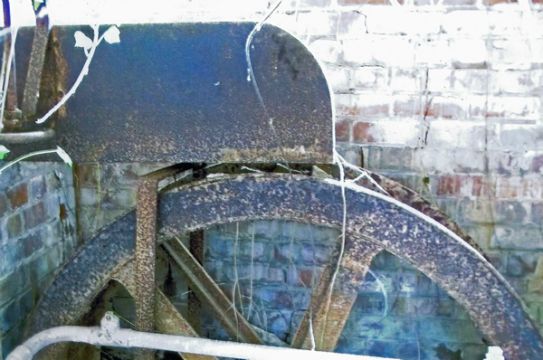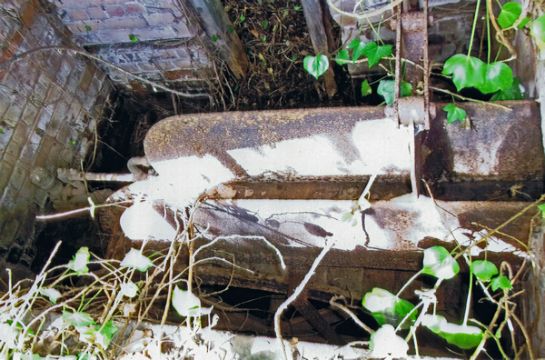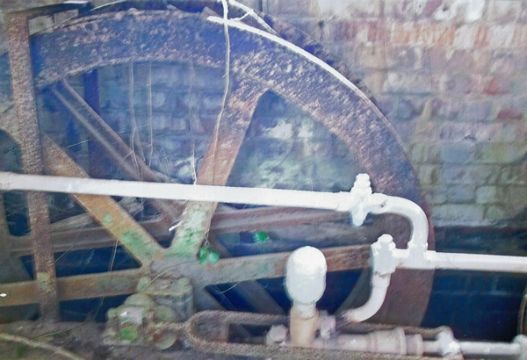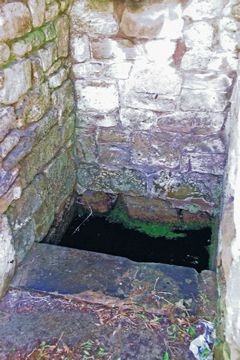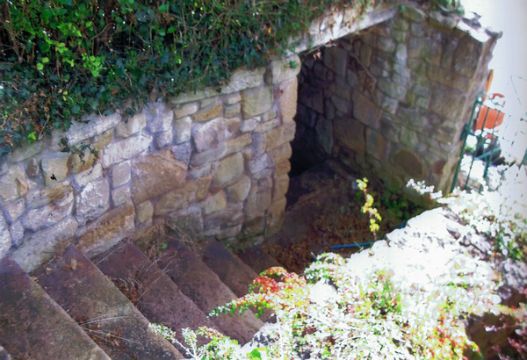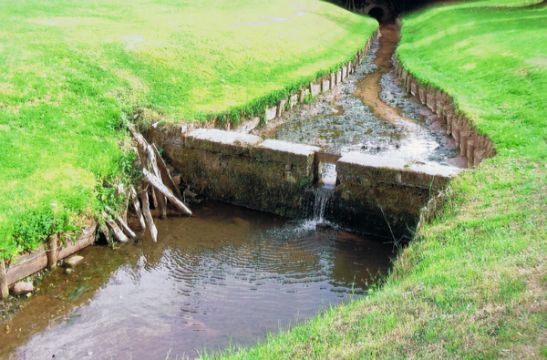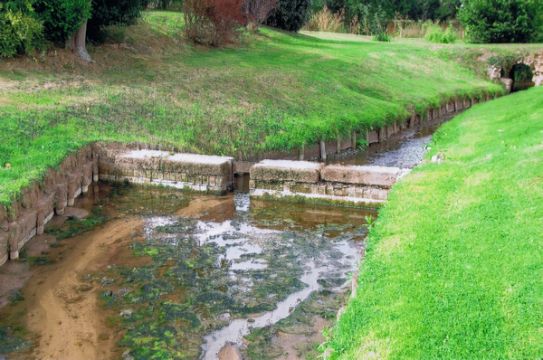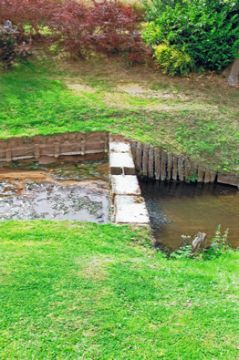Threapwood Springs and Wells.
By Dudley Realff
Threapwood, despite not being close to a major waterway, was not short of water. Firstly there are three brooks which run through the area – Wych Brook marks the southern boundary of the village with Paradise Brook which, as a tributary, runs through the village and the northern boundary is Flennens Brook which flows north to Shocklach. Secondly, owing to the underlying soil structure there also several springs which kept the settlement well watered. Even so this came at a price as the daily collection of water for both home and business was for many a laborious affair. Obviously this daily chore was the same for every village and town in the land and sadly, still is a feature of daily life in many parts of the world. There are three major springs in or close to Threapwood, all of which are still flowing.
Firstly, just beyond the Brickworks site on the right hand side of the road going towards Malpas there is a spring which fed a large part of the village. There was a small brick building, now gone, with a sump built into it through which the water flowed. This was an important source of water from which villagers collected their daily supplies. Lucy Williams remembers going to this spring with a shoulder yolk for the needs of their home and market gardening business which her father ran. In summer this required several daily trips and she also remembers that there were frogs in the sump which her father assured her helped to keep the water pure!! Sometime, probably in the 19th century, the overflow from this spring was diverted into an enclosed gully/culvert which then ran down the right hand side of Oldcastle Lane to supply water for the horses and livestock at Broughton Hall and Middlewood Farm. This gully/culvert also fed wells in Sandy Lane where the Hewitts and Cluttons lived and on to Back Lane where Shilloms lived.
At the corner of Lower House and Greens Lane there was a well and the then owner of Lower House, Fred Atkins, diverted some of the water to form a pond as a source of water for his cows during each day. Water from this spring also went to Upperwood Farm where the Pickerings lived. Here there is still a small building housing an overshot water wheel which worked a metal pump which also pumped water to Broughton Hall.
|
{image.index}/{image.total}
|
The pump is depicted in the three photos left and described further on below. |
It is also likely that this same spring and gully fed the wells at The Holy Land and Frontier House. The water from this spring will also have been used in the production process of making the bricks and land tiles. This spring water still flows down the gullies/culverts but also into abandoned or landscaped ponds which are all that are left of this once big part of daily life and the small industry that once existed at the Brickyards.
|
{image.index}/{image.total}
|
Secondly, the Well House at the Sarn which can still be seen (see photos left) must have been a very popular source of water supply. |
This building and the sump attracted people from as far away as the Whalebone area who were said to collect their water from here. This spring, according to Liz Crump (nee Blything) was delightful to drink, but was considered to be hard. Water from this spring was fed to the Queen’s Head as the Wych Brook was polluted by both human and animal waste from the cottages backing onto the brook. The Queen’s Head itself being one of the offenders! This pollution was eventually stopped by the Malpas RDC.
Sarn Bank Farm also had water from this spring pumped up the hill to it and any surplus water was emptied into the brook. Thirdly, there was a spring on the land between Threapwood and Tallarn Green which was reliable and sufficient enough to support a Water Cress enterprise which supplied local markets. Another feature of the need to move significant quantities of water some distance particularly for farm livestock was the installation of various pumps in the area. Further to the one at Upperwood Farm, there was one on the Sarn/Tallarn Green border where the brook goes under the road. The brook was widened and dammed enough to raise the water level so that the overflow would drive a wheel which pumped water up to the Cae-li-Cae Farm for both the house and livestock.
|
{image.index}/{image.total}
|
What is left of this set-up can be seen in these photos (left). |
There were other systems housed in small pump houses such as the one at the end of the Caenant Wood by the Queens Ford Bridge which pumped water along 1.2km of lead pipe to the cellars of Broughton Hall (see the article "Broughton Hall Water Supply"). It may seem that BH got more than its fair share of water but it should be remembered that that at that time it was a large estate with the hall, a dairy farm and local cottages to supply. At quite a few places, where labour and/or money were available wells were dug. This was a skilled process as some of them were over 30 feet deep.
Attached is a very descriptive article written by Roly Wyatt of the original Wyatt Brothers at Whitchurch. His article has been helped by the fact that recently Roly happened to be in a hospital bed next to another man who had been a ‘Well Sinker’! Click here to Read Roly's Article.
A very interesting description of the Wyatt family and the company they established in Whitchurch can be accessed by clicking here.
We are also grateful to Roly for a copy of an extract from one of his books of the making of pumps and pipes from Elm wood. At the time covered by this research residents of the village would carry what water was necessary from the nearest spring, well, pump or brook – this was obviously relative what could be carried by whom and how often.
With personal hygiene governed by how much water was available the weekly bath for all the family used the same bath water and the order was determined by seniority so Dad first and the baby last – hence the saying about “not to throw the baby out with the bath water!” Water for baths was frequently taken from the nearest brook or rain butts around the house – these latter containers would likely have been ‘coloured’ by whatever the roof had to offer such as bird droppings, leaves and soot? We know from the interviews with residents that sharing pumps and well water with neighbours and friends was common but one suspects that with Threapwood’s early reputation this privilege was not available to everyone!
As can be seen the need for water was satisfied by the usual mixture of hard work and ingenuity and in what one hopes was neighbourly help when needed. However, all this ended in 1957 when mains water became available in the village to the relief of everyone. The daily slog became a thing of the past and now we all have as much water as we need. But the reminders of the ‘old days’ are still there – the old pump houses lie crumbling, overgrown and mostly forgotten. Nevertheless, the springs still run on and many of us have wells in our gardens/yards which are sometimes decoratively painted and/or planted with flowers and are used as a feature. Some wells have been brought back into use with modern electric pumps where properties have been bought with an inadequate water supply or to just to save money on the water bill?
Addendums
From Alan Hooper
Subsequent to this article being written, we have received the following memory from Alan Hooper now living in the USA. Alan, it may be remembered, was brought up in Threapwood and gave us information on the Brickworks as he remembered them. He reads of the Threapwood History Group on-line and is very grateful to be kept informed of "a place I still love and remember". What he recalls is very similar to that of the late Lucy Williams and is as follows;
" I read the article on the "Springs & Wells" and have another Well to add to your list. In the field in front of the Hollies down the bank close to the stream is a well that we used as a kid. This well had frogs in it which my Mother always thought that it would be good to drink out of. Unfortunately, the cows that Nate Dulson had in that field drank from the same well. I guess they preferred it to the stream. At this time Mother decided we would use the water from the pump at Shilliam's Farm and I can remember the many times I carried a bucket of water across the fields from Shilliams to home. We used Shilliam's pump for the rest of the time we lived in Threapwood.
From Stuart Griffin
These notes refer to the dangers of entering a brick lined well when health and safety precautions and legislation was not even envisaged. They relate specifically to the article above written by Roly Wyatt.
"From what I was told by a very kind man who worked with my grandfather you are correct in the way that they were built.
Unfortunately grandfather did get gassed in a well . They used to test for gas by putting a candle down on a bit of string. If the flame went out, you should keep out. Unfortunately he didn’t so that killed him just before the war.
The well was finished and there was a problem with it. He went round in the evening, something that he should not have done as because you mentioned, the dangers of working in them. The men who worked for him would not let him go down as if one of them got killed the other workers would still have employment and there families would be ok. Unfortunately afterwards they were all layed off, apart from one who always looked after grandmother and the family and was a good grandfather but he was never called that".

